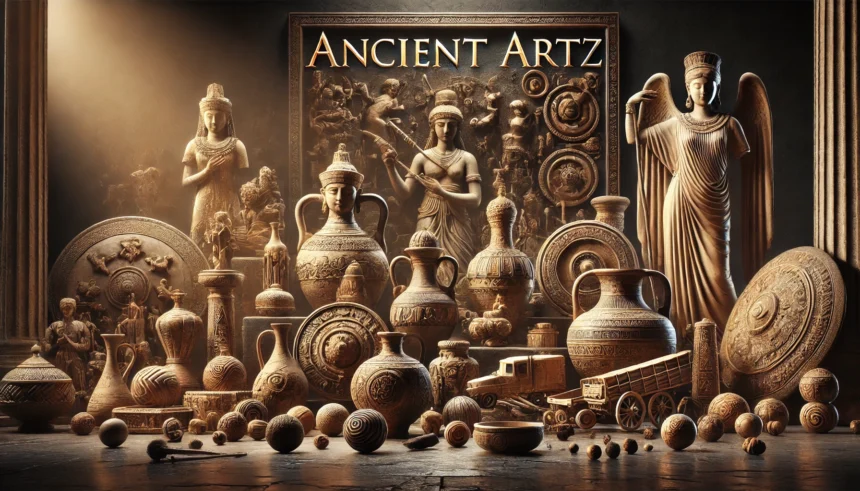Ancient Artz refers to various artistic symptoms that emerged from societies that existed quite earlier the modern period. This form of art, spanning from prehistoric cave paintings to the intricate sculptures of ancient Greece, has always been a mirror reflecting the culture, values, and beliefs of its creators. Through AncientArtz, we can explore the social structures, religious practices, and everyday life of past civilizations. Not only does AncientArtz hold immense artistic value, but it also serves as a historical record, capturing the emotions and ideals of the ancient world.
Why Study Ancient Artz?
Understanding Ancient Artz is essential to grasping the advancement through human civilization and cultural development. These masterpieces offer a glimpse into the minds and lives of ancient people, revealing their beliefs, traditions, and technological advancements. Whether it’s a mysterious cave painting or a regal Egyptian statue, AncientArtz tells stories that words alone cannot express. Furthermore, it connects us to our collective history, allowing us to appreciate the richness and diversity of human creativity over millennia.
Types of Ancient Artz
Cave Paintings and Rock Art
One of the earliest forms of Ancient Artz is found in the prehistoric cave paintings that date back tens of thousands of years. Examples like the Lascaux Caves in France and the Altamira Cave in Spain feature vivid depictions of animals, handprints, and symbols. The aforementioned antique paintings provide insights to either psychological & utilitarian existence the ancient humanity. Some theories suggest that these paintings were part of rituals to ensure successful hunts or served as a means of communication among groups.
Sculptures and Statues
Sculpture is another prominent form of Ancient Artz that continues to captivate the world. From the monumental statues of Ancient Egypt, such as the Great Sphinx and Pharaoh statues, to the lifelike depictions of gods and athletes in Ancient Greece, sculptures were used to immortalize important figures and ideals. These statues were not merely decorative but symbolized political power, religious beliefs, and the beauty of the human form. The Venus of Willendorf, an ancient fertility figurine, is another iconic example of early sculpture that reflects the values of prehistoric societies.
Ancient Pottery and Ceramics
Pottery is one of the most enduring forms of Ancient Artz, with evidence found in virtually every ancient civilization. Greek vases, Roman pottery, and Chinese ceramics are examples of how functional objects were often decorated with artistic designs. These items were used in everyday life but also had symbolic significance, often depicting scenes from mythology, daily activities, or important historical events. The designs on pottery and ceramics provide us with valuable clues about the social structures, beliefs, and cultural practices of ancient civilizations.
The Cultural Significance of Ancient Artz
Religious and Spiritual Expression in Ancient Artz
Religion was central to most ancient societies, and Ancient Artz often served as a reflection of these spiritual beliefs. In Ancient Egypt, gods like Ra, Osiris, and Isis were depicted in elaborate artwork, representing the importance of the afterlife and divine power. Similarly, Ancient Greek art frequently honored gods like Zeus and Athena, with statues and paintings designed to express their divine beauty and power. In Ancient India, religious art, including Buddhist sculptures and Hindu temple carvings, was integral to both worship and storytelling.
Political and Social Influence in Ancient Artz
Art was not only a spiritual tool; it was also a means of conveying political power. In Ancient Rome, emperors and military victories were immortalized in monumental sculptures, such as the Column of Trajan, which depicted the Emperor’s triumphs in a series of detailed reliefs. Similarly, Ancient Egypt used grand monuments, like the Pyramids and the Statue of Ramses II, to promote the power of the Pharaoh and the gods he represented. These forms of Ancient Artz were created to showcase power, dominance, and the divine right of rulers.
Ancient Artz as a Historical Record
Ancient Artz also serves as an invaluable historical record, offering a glimpse into the daily lives, rituals, and events of ancient people. Ancient art wasn’t just about beauty—it was a way to document important figures, wars, and cultural practices. The Assyrian reliefs from Mesopotamia, for example, show scenes of warfare, royal hunts, and religious ceremonies. These artworks allow us to piece together history in ways that written records often cannot.
Famous Examples of Ancient Artz
Egyptian Ancient Artz
The Ancient Egyptian civilization is known for its distinctive art style, which was largely focused on the afterlife and the gods. The Great Pyramids of Giza and the Temple of Karnak are monumental examples of Egyptian architecture and artistry. Additionally, Egyptian tomb paintings and sculptures, such as the Bust of Nefertiti, reflect the civilization’s religious and political ideologies.
Greek and Roman Ancient Artz
Greek and Roman art influenced much of the Western art tradition. The Parthenon, with its intricate sculptures, is a prime example of Ancient Greek Artz, highlighting ideals of beauty, symmetry, and divine order. Roman mosaics and sculptures, including busts of emperors, were often used to immortalize public figures and military conquests, making Ancient Artz a key tool for propagating the power of the state.
Mesopotamian Ancient Artz
In Mesopotamia, Ancient Artz was used to celebrate gods, kings, and significant historical events. The Ishtar Gate, with its blue-glazed bricks and lions, stands as one of the finest examples of Babylonian art. The Stele of Hammurabi, one of the earliest known law codes, is another example of how AncientArtz was used to document legal and political matters.
Chinese and Indian Ancient Artz
Ancient Artz from China and India has a spiritual focus, with numerous sculptures, paintings, and ceramics that honor deities and commemorate important cultural traditions. The Terracotta Army in China, created to protect Emperor Qin’s tomb, and the Buddhist sculptures of Ancient India reflect the deep connection between AncientArtz and religious practice.
Techniques Used in Ancient Artz
Materials and Mediums in Ancient Artz
The materials used in Ancient Artz varied widely across civilizations but often included stone, clay, bronze, and natural pigments. For instance, Egyptians used limestone and granite for their statues, while Greeks worked with marble. The pigments used in cave paintings and pottery were sourced from minerals and natural elements, often mixed to create vivid colors that have stood the test of time.
Artistic Techniques in Ancient Artz
The techniques used in Ancient Artz were diverse and sophisticated. Sculpting was a major technique in AncientArtz, with early forms of chiseling and engraving used to create lifelike statues and reliefs. Pottery and ceramics were often painted or engraved with intricate designs, telling stories or depicting daily life. Techniques like fresco painting and mosaic work also played a significant role in AncientArtz, especially in places like Ancient Rome and Greece.
Preservation and Legacy of Ancient Artz
How Ancient Artz Has Survived Through Time
One of the most impressive aspects of Ancient Artz is its preservation. Despite the ravages of time, many works of AncientArtz have survived due to the materials used, the efforts of restorers, and the discovery of these artworks in tombs, ruins, and excavation sites. Museums around the world house invaluable pieces of AncientArtz, offering a window into the past for future generations.
The Influence of Ancient Artz on Modern Art
The influence of Ancient Artz can be seen in modern art and architecture. From the neoclassical style in the 18th and 19th centuries to the use of ancient symbols in contemporary design, AncientArtz continues to inspire. Many modern artists, architects, and designers draw inspiration from the forms, techniques, and cultural symbolism found in Ancientrtz.
Conclusion
Ancient Artz is much more than just a visual expression; it is a testament to the creativity, beliefs, and achievements of ancient civilizations. From prehistoric cave paintings to the grandeur of Roman and Egyptian sculptures, AncientArtz allows us to connect with our past, appreciate cultural diversity, and understand the evolution of human expression. Exploring AncientArtz is a journey through history, and its timeless influence continues to shape modern culture today.
Frequently Asked Questions (FAQs)
What is Ancient Artz?
AncientArtz refers to the art created by early civilizations, such as paintings, sculptures, pottery, and carvings, which reflect the culture, beliefs, and daily life of the people who created them. Examples include cave paintings, Greek sculptures, and Egyptian monuments.
Why is Ancient Artz important?
AncientArtz is essential because it provides insight into the values, beliefs, and practices of ancient civilizations. It serves as both a historical record and a cultural expression, allowing us to understand past societies and their influence on modern culture.
What are the main types of Ancient Artz?
The main types of AncientArtz include cave paintings, sculptures, pottery, and architectural designs. Each type served different purposes, from religious expression to documenting historical events and daily life.
How has Ancient Artz influenced modern art?
AncientArtz has had a great impact on modern art and design. From classical sculpture to architectural styles and even modern graphic design, the techniques, symbols, and aesthetics of ancient art continue to inspire contemporary creators worldwide.
Where can I see examples of Ancient Artz?
You can view examples of AncientArtz in major museums such as the Louvre Museum in Paris, the British Museum in London, and the Egyptian Museum in Cairo. Many ancient works are also accessible through online databases and virtual museum tours.
Article Recommendations:
Dunbarton Umbagog Gordo Gordo Holts: of Discover the Hidden Gem
MyDearQuotes.com Quotes Archives: Inspiration at Your Fingertips






